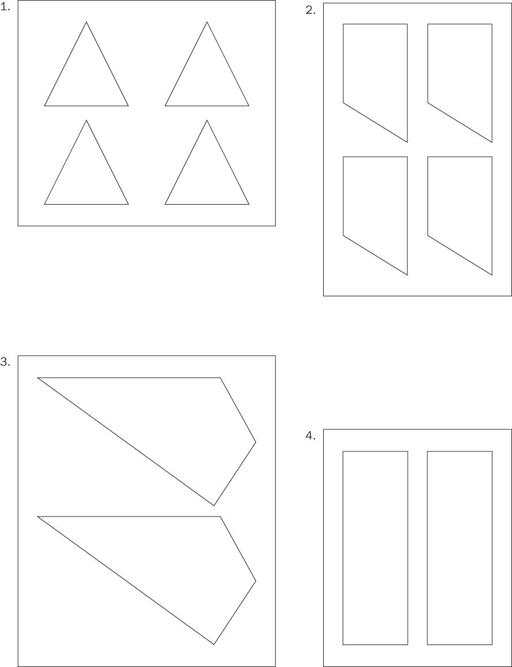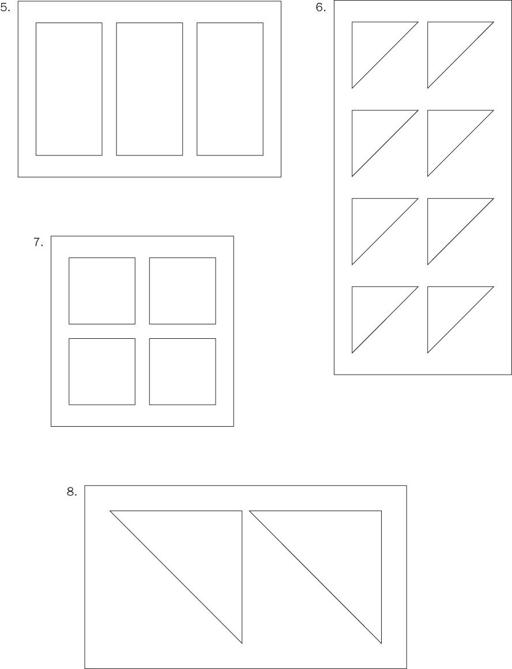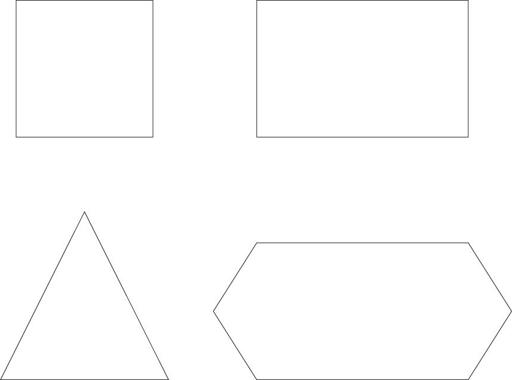Teaching the Common Core Math Standards With Hands-On Activities, Grades 3-5 (21 page)
Read Teaching the Common Core Math Standards With Hands-On Activities, Grades 3-5 Online
Authors: Judith A. Muschla,Gary Robert Muschla,Erin Muschla-Berry
Tags: #Education, #Teaching Methods & Materials, #Mathematics, #General

BOOK: Teaching the Common Core Math Standards With Hands-On Activities, Grades 3-5
5.26Mb size Format: txt, pdf, ePub
1.
Distribute copies of the reproducibles. Explain that on “Parts of Figures, I” and “Parts of Figures, II” each group of figures in each box can be assembled to form one of the figures (a triangle, hexagon, square, or rectangle) contained on “Geometric Figures.”
2.
Explain that students should start with the figures in the first box. They should cut out the triangles and assemble them to form a figure shown on “Geometric Figures.” After students have assembled the small figures, on a separate sheet of paper they should write the number of the box of the small figures, the fraction of the area each small figure makes up of the larger figure, and the name of the larger figure.
3.
Instruct students to follow the same procedure for the figures in the other boxes.
Closure
Discuss your student's results. Emphasize the unit fractions as parts of their wholes.
Answers
(1)
The area of each part isof the area of the triangle.
(2)
The area of each part isof the area of the hexagon.
(3)
The area of each part isof the area of the hexagon.
(4)
The area of each part isof the area of the rectangle.
(5)
The area of each part isof the area of the rectangle.
(6)
The area of each part isof the area of the square.
(7)
The area of each part isof the area of the square.
(8)
The area of each part isof the area of the square.
Parts of Figures, I
Parts of Figures, II
Geometric Figures
Section 2
Standards and Activities for Grade 4
Operations and Algebraic Thinking: 4.OA.1
“Use the four operations with whole numbers to solve problems.”
1. “Interpret a multiplication equation as a comparison, e.g., interpretas a statement that 35 is 5 times as many as 7 and 7 times as many as 5. Represent verbal statements of multiplicative comparisons as multiplication equations.”
Other books
Elementary Virtue: The Prophecy by Sonja Wuthrich
Project Aquarius (The Sensitives Series Book 1) by Colleen Jordan
The Follies of the King by Jean Plaidy
Over the Edge by Jonathan Kellerman
A Guilty Mind by K.L. Murphy
Conrad & Eleanor by Jane Rogers
The New Year's Bride (Holiday Mail Order Brides Book Two) by Morgan, Kit
2041 Sanctuary (Dark Descent) by Robert Storey
The Folly by Irina Shapiro
The Good Friday Murder by Lee Harris



